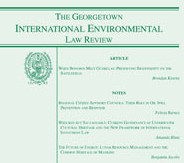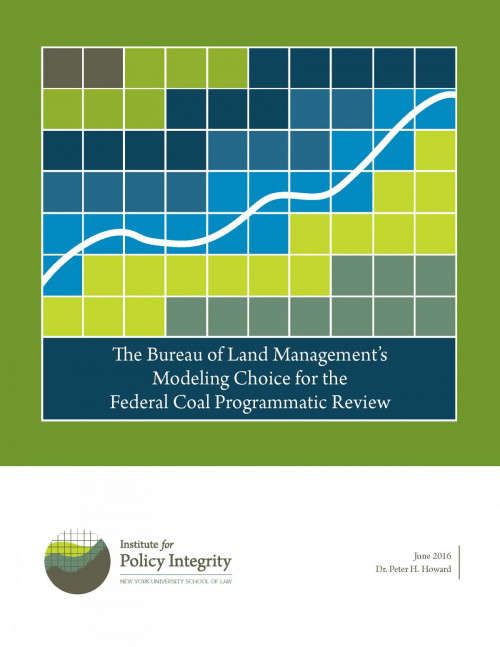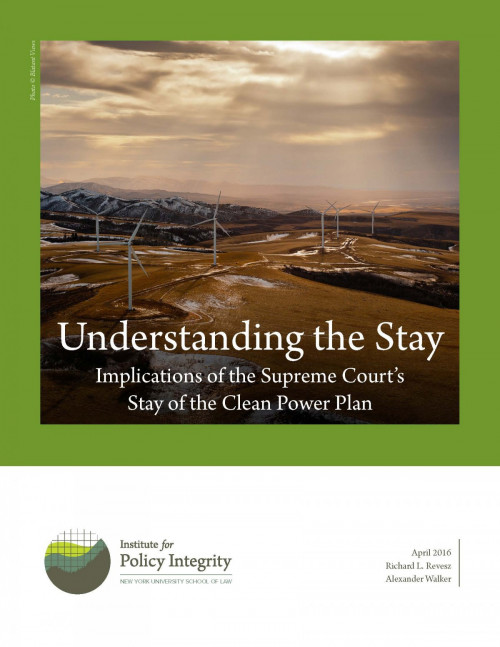-

Legal Pathways to Reducing Greenhouse Gas Emissions Under Section 115 of the Clean Air Act
The most efficient legal tool for addressing U.S. climate pollution can likely be found in an unused provision of the Clean Air Act. Section 115 of the Act, titled “International Air Pollution,” authorizes the EPA to develop and implement an economy-wide, market-based program to reduce domestic greenhouse gas emissions. This article, jointly authored by a team of law professors and attorneys at three of the country’s leading institutes focused on climate change and environmental law, offers an in-depth analysis of Section 115, which would provide the most flexible approach for achieving the targets from the Paris climate agreement.
-

The Bureau of Land Management’s Modeling Choice for the Federal Coal Programmatic Review
There are multiple power sector models available to the Department of Interior (DOI)’s Bureau of Land Management (BLM) for analyzing the effect of current and alternative coal regulations and leasing policies during preparation of its programmatic environmental impact statement (PEIS). This document lays out model selection criteria to assist BLM in weighing the benefits and costs of these available models, and offers recommendations for model selection, highlighting the tradeoff between model complexity and transparency.
-
Revesz Testifies at Senate Hearing on Clean Power Plan
On June 9, Richard Revesz testified at a Senate Environment and Public Works Committee hearing focused on the Supreme Court’s stay of the Clean Power Plan.
-
The Turn Toward Toxins
An Essay Review
A growing number of historians have begun to turn their attention to crucial transitions in the ‘chemical age’ of the 20th century in order to understand both how ‘invisible’ chemicals endangered the environment and public health as well as how science and technology mediated perceptions of this danger. Several important new works have demonstrated the need for scholarship not only on the environmental and health effects of pollutants, but also on how institutions and governments began to care about such changes and define them positively or negatively.
-
National Academy of Sciences Reviews Social Cost of Carbon
The National Academy of Sciences (NAS) is currently conducting a review of the methodologies used to calculate the Social Cost of Carbon (SCC). We submitted comments to NAS to help inform this process.
-
Distributed Energy Compensation Comments for NARUC
As distributed energy resources (“DER”) are becoming increasingly common, the debate on how customers with such systems should be compensated is intensifying in many states. The National Association of Regulatory Utility Commissioners (NARUC) is creating a Distributed Energy Resources Compensation Manual to assist states with these policy decisions. We recently submitted comments to NARUC’s Staff Subcommittee on Rate Design regarding the most economically desirable approach to use for DER compensation.
-

Understanding the Stay
Implications of the Supreme Court’s Stay of the Clean Power Plan
Since the Supreme Court stayed EPA’s Clean Power Plan, which regulates carbon dioxide emissions from existing fossil fuel-fired power plants, opponents of the plan have been making unfounded assertions about the consequences of the stay. This policy brief aims to clarify the stay’s implications for EPA’s implementation work and the plan’s future compliance deadlines.
-
Handbook of Regulatory Impact Assessment
Jason Schwartz, legal director at the Institute for Policy Integrity, authored a chapter in the new Handbook of Regulatory Impact Assessment. Schwartz’s chapter explores the varied applications and approaches to cost-benefit analysis in the context of regulatory impact assessment.
-
New York Clean Energy Standard - White Paper Comments
The 2015 New York State Energy Plan set one of the most ambitious clean energy targets in the nation: 50 percent of all electricity used in the state should be generated by renewable energy sources. The Department of Public Service Staff recently released a White Paper on the Clean Energy Standard, with recommendations on how to achieve this ambitious goal. We submitted comments to the New York State Public Service Commission, outlining some additional steps that can help ensure that the Clean Energy Standard is not excessively costly, and is effective in achieving all of its policy goals.
-
Comments on BLM Rule to Control Fugitive Methane Emissions
We recently submitted two sets of public comments to the Bureau of Land Management (BLM) regarding a proposed rule to reduce waste of natural gas from venting, flaring, and leaks during oil and gas production on federal and Indian lands. BLM has proposed making natural gas lost through these processes subject to royalty payments.

